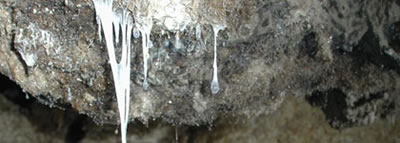Extremophiles are organisms that live in physically extreme conditions that would be deadly to most life on Earth.
Most extremophiles are microscopic in size.
Many extremophiles are archaea.
Some bacteria are extremophiles.
Hyperthermophiles are extremophiles that thrive in places where temperatures are extremely hot, such as hydrothermal vents in the oceans, where heated water erupts from beneath the surface of the Earth.
 Some scientists think that life on Earth may have begun in hydrothermal vents.
Some scientists think that life on Earth may have begun in hydrothermal vents.
Thermophiles live where temperatures are slightly lower, but still very hot.
Other extremophiles, which are known as cryophiles or psychrophiles, live in environments with very low temperatures, such as in polar ice or in permafrost - a perpetually frozen layer of soil that can be found in polar regions.
Xerophiles are extremophiles that live in very dry environments. They include bacteria that live in the Atacama Desert, the driest desert on Earth.
Some extremophiles live in very acidic or very alkaline environments or in places with very high concentrations of salt or of heavy metals, such as copper or arsenic. These are known, respectively, as acidophiles, alkaliphiles, halophiles, and metalotolerants.
Other extremophiles, known as barophiles or piezophiles, can withstand extremely high pressures. They can be found underneath the Earth's surface and deep in the oceans.
Some extremophiles, which are called endoliths, live inside rocks, shells or coral. Sometimes, they live inside the tiny spaces between interlocking grains of mineral. There are endoliths that live in the Earth's crust, almost two miles below the surface.
Some endoliths are lithoautotrophs. This means that they get their energy by breaking down mineral compounds in rock.
Lithoautotrophs are sometimes known as chemolithoautotrophs.
There are even extremophiles that thrive in environments where there are high levels of nuclear radiation (are radioresistant).
Cave Slime
Cave slime are bacteria that live on the ceilings and walls of caves where there are high levels of hydrogen sulfide, a substance that is poisonous to most living things on Earth.
These bacteria get their energy by breaking down the hydrogen sulfide in the rock and converting it to sulfuric acid.
The sulfuric acid that is produced by cave slime breaks down the cave's walls, causing the cave to grow larger.
Some cave slime produce slimy, mucus-like projections that hang from ceilings and ledges. These projections are known as snottites.
Phlegm balls are gooey mats made up of cave slime secretions.
Multicellular Extremophiles
Most extremophiles are one-celled organisms.
However, in 2010, a team at the Marche Polytechnic University in Ancona, Italy, led by Roberto Danovaro, reported that they had discovered three species belonging to the phylum Loricifera – microscopic marine animals that live attached to grains of sediment - in L’Atalante basin on the bottom of the Mediterranean Sea, where they live and reproduce in an oxygen-free environment.
They are the only multicellular organisms that we know of that can live without oxygen.
L’Atalante basin, which is about 120 miles west of Crete, is a large brine lake – an area of the ocean floor that is much saltier than the waters that surrounds it. The salt in L’Atalante basin is so thick that its waters aren’t able to mix with the waters above it, which contain oxygen.
Therefore, L’Atalante Basin is an anoxic (oxygen-free) habitat.
In addition, its waters are full of hydrogen sulfide gas.
These three species of Loriciferans do not have mitochondria in their cells. Mitochondria are found in most animal and plant cells. They are organelles (cell bodies) that provide the cell with energy.
Mitochondria use oxygen to produce energy.
Instead of mitochondria, these three species of Loriciferans have organelles that are similar to hydrogenosomes, organelles that are used by single-celled anaerobic organisms (organisms that do not need oxygen to survive) to produce energy without oxygen.
The three newly discovered species were assigned to three different genera: Spinoloricus, Rugiloricus and Pliciloricus. The species belonging to the genus Spinoloricus was named Spinoloricus cinzia, after Danovaro’s wife.
Loriciferans get their name from the fact that they are surrounded by a protective covering that is known as a lorica. ("Lorica" is Latin for "girdle" or "body armor").
They are also sometimes known as brush heads.
The Danish biologist Reinhardt Kristensen was the first to identify the Loricifera, in 1983.
Loriciferans look like jellyfish inside shells.
Their bodies have five sections: a mouth cone, a head that can be withdrawn into the body, a neck, a thorax and an abdomen.
Loriciferans go through a larval stage. The larvae look nothing like the adults.
Extraterrestrial Life
The study of extremophiles can help us understand whether life could exist in our Solar System, outside the Earth, and if so, where.
The conditions in which extremophiles live resemble conditions on other planets and their moons.
For example, there are extremophiles that live in cold, dry areas of Antarctica where conditions are similar to those on Mars.
The soil of the Atacama Desert, where extremophiles can be found, resembles Martian soil.
Organisms like cave slime could live beneath Mars' surface.
Europa, a moon of Jupiter, has a layer of ice, which astronomers think may cover an enormous ocean.
Hydrothermal vents beneath this ocean could contain organisms similar to those that live in hydrothermal vents on Earth.